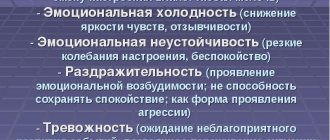.
The problem of career guidance becomes more complicated every year; many new professions appear on the labor market, but a number of familiar ones that have existed for decades are disappearing. Choosing a suitable job for a teenager is not easy; it all depends on his inclinations for different types of activities, interests, environment, as well as on many other equally important factors.
Deciding on a future profession is not easy for teenagers
How can a teenager decide on a profession so that in the future he can achieve success in what he likes? And most importantly, how to make sure that in 5–10 years this person does not have to go to an unloved job every day and dream of another profession.
Professional guidance for students
Vocational guidance is a whole system of activities developed by experts that are aimed at facilitating the choice of profession for schoolchildren. In the process of their preparation, the characteristics of each individual and the socio-economic situation in the country must be taken into account.
Career guidance at school consists of 3 main components:
- Education. Students and graduates of secondary schools will learn about current professions and their characteristics, current personnel needs, requirements imposed by employers, opportunities for career growth and self-development. Thanks to educational activities, adolescents develop motivated professional intentions, which are based on an analysis of the labor market, as well as their own mental and physiological capabilities (inclinations and abilities).
- Consulting. Helping a schoolchild with professional self-determination is expressed in recommending to him those vectors of work activity that best correspond to the characteristics of his psyche and physiology. Advice is based on the results obtained during preliminary career guidance diagnostics.
- Psychological support. The use of techniques aimed at reducing psychological tension, creating an optimistic attitude and a feeling of confidence in the future.
Career guidance for teenagers is one of the important factors influencing their choice of profession in the future. The main goal of such work is to develop in children a conscious attitude towards any work, as well as their professional self-determination, taking into account personal capabilities, abilities and needs of the labor market.
Tests and methods for career guidance
A career guidance test is the first thing that usually comes up when parents think about choosing a child’s profession. It is important to mention the limitations. Most methods were developed quite a long time ago, so the wording of their questions may sound quite strange to a modern teenager. In addition, the methods offered as possible professions are far from relevant now, and even downright outdated. The professional areas into which the tests divide professions are very arbitrary and do not always correspond to current realities, especially taking into account the trend towards interdisciplinarity of professions. However, career guidance methods can be the first step to determine the scope of your future profession.
Relevance and objectives of career guidance for schoolchildren
Working with professional self-determination at school age requires mandatory consideration of the level of intellectual and psychological development of the child. Naturally, it will be different in elementary, middle and high schools.
Probably, many have observed that at about 10-12 years old, children often change interests. For example, today a teenager signs up for a photography class. His parents buy him a camera and everything he needs for photography, and the next day he completely forgets about his desire to shoot and asks for a robotics kit. Therefore, at this age it is too early to seriously discuss professions (although there may be exceptions). The formation of sustainable interests occurs approximately in grades 8-11.
Thus, full-fledged vocational guidance for schoolchildren can be carried out from the age of 13. Of course, each student is individual. Some already know exactly what they want at the age of 10, and have even drawn up a plan for at least a decade in advance. And someone cannot give a clear answer to the question about interests and hobbies at 17. It cannot be said that in the second case we are dealing with infantility - everyone has their own pace of development. There is no point in scolding for this, but help with self-determination during this period is very important and necessary.
Let's consider how to conduct career guidance work with children in elementary school, middle and high school.
1-4 grades
For elementary school students, almost all activities take place in the form of games. Children play, for example, teachers, doctors, police officers, drivers, trying on adult roles. This way they learn to value work and realize its importance for society, and the class teacher helps them in this through educational, cognitive and research activities. At this age, students’ knowledge of modern professions is not rich. They only know what they heard from their parents and close relatives.
The main task of early career guidance for children is to determine the child’s area of interest and fill it with new information about various types of activities. At this stage, it is extremely important for the student to develop a complete understanding of the variety of professions that exist today. This will give him the opportunity to avoid a number of mistakes when making plans for the future in high school.
5-7 grades
At this age, a pronounced association of the profession you like with one or more academic subjects is clearly visible. Schoolchildren express preferences and wishes when choosing leisure activities (clubs, sections, hobbies), and are interested in what their parents do at work. Many teenagers during this period are attracted to fashionable trends, but therein lies a danger. After all, trends are usually changeable and short-term, so they are not suitable as a goal for the future.
Career guidance for students in grades 5-7 helps them focus on individual abilities and skills, and also takes a closer look at activities that interest them. The main goal of career guidance for schoolchildren at this stage is to find a profession in which the best personal qualities and strongest sides of the child will be revealed to the maximum.
8-9 grades
At the age of 14-15, interest in professions becomes more specific and becomes much more conscious. In addition to studying, at this stage teenagers are more actively involved with tutors, enroll in training courses, and review university programs. The choice of direction, as a rule, is based on the student’s inclinations and characteristics of his character.
Professional self-determination of students in grades 8-9 helps to find answers to the questions “What do I need?”, “What kind of work is this?”, “What if I choose the wrong university?” The result of competently conducted career guidance at this age is preparedness to choose a type of activity in the future, the ability to draw up a plan for obtaining the desired profession.
10-11 grades
Unfortunately, today many graduates take the Unified State Exam without knowing what they want to become. At this stage, career guidance work is especially important, as it can guide the teenager to make the right decision. If you neglect it, the student risks choosing a secondary technical or higher educational institution unsuccessfully, getting an irrelevant or unsuitable profession and, as a result, problems with employment.
Schoolchildren in grades 10-11 are taught independence in development, and their level of readiness for the chosen type of activity is assessed. Graduates begin to actively realize the goals they have set for themselves: they choose training courses and make adjustments to their own professional plans.
Career guidance for high school students makes it possible to reduce the level of stress caused by impending admission and get rid of doubts when choosing subjects for the Unified State Exam and the direction of study. In addition, it helps you plan your professional future wisely.
Features of teenage career guidance
The choice should be:
- Conscious . A teenager must understand for himself what he wants to do. Enrolling in the same specialty with a friend, studying because it’s fashionable, or “they earn good money” are external factors. There must be other reasons, internal, why he wants to do this or that business, and they need to be determined.
- His own. Neither my mother’s dream, nor the traditions of my father’s family, in which all men become surgeons, should become the main motive when making a decision. Your dreams and plans are yours, give your teenager freedom, because it will determine his entire subsequent life.
- Based on his interests, abilities and skills . Just because your child draws well does not mean that he needs to study to become an architect. It could be a hobby. What if he is a talented physicist, but he hasn’t realized it yet? It is necessary to conduct more in-depth career guidance research, rather than make superficial decisions.
Career guidance for high school students according to Federal State Educational Standards
The career guidance program at school according to the Federal State Educational Standard, which explains the goals, objectives and methods of professional self-determination of schoolchildren, is focused mainly on achieving personal results:
- a balanced choice of profession and opportunities to implement your plans regarding employment;
- a formed attitude towards future work as an opportunity to solve personal, social, state and even global problems.
The teacher implements this program in the teaching process (within a specific subject or during extracurricular conversations):
- provides the most complete information that may be useful to the student when choosing a profession;
- provides an opportunity to practice professional activities based on knowledge acquired in the subject;
- creates conditions for the development of individual projects and helps in the implementation of already completed ones.
In 2020, the Agency for Strategic Initiatives presented the web product “Atlas of New Professions” - an excellent tool for professional self-determination for high school students. It provides an understanding of how the knowledge acquired during the study of a subject can be applied in the future, in which areas of activity it will remain relevant, and also allows you to track the emergence of new professions. Let's take the field of medicine as an example. Already now or in the next few years, the country will need IT doctors, medical equipment architects, network doctors, genetic consultants, clinical bioinformaticians, medical marketers, health care facility designers, healthy aging consultants, molecular nutritionists, developers of bionic implants and cyber prostheses, bioethicists, medical robotics operators.
Most new professions require knowledge in several areas at once. Therefore, a teacher introducing a school program for career guidance must not only have a good command of his subject, but also have a good understanding of related ones.
A teenager's readiness for professional self-determination
Choosing a profession involves serious intellectual work and active search. Experts in the field of career guidance operate with the concept of readiness for professional self-determination. It is expressed in a person’s interest and ability to make this choice, based on his personal resources and available information.
To understand the levels of students’ readiness for professional self-determination, it is important to correctly assess several parameters.
| Indicators | Markers | Important components |
| Internal readiness | Self awareness | Healthy self-esteem of one’s own inclinations, preferences and skills, academic achievements, character traits and temperament. |
| Responsibility | A firm understanding of the need to independently choose the type of activity and the willingness to take full responsibility for it. Resistance to pressure from relatives, teachers, and close circle. | |
| Emotional mood | Motivation and positive attitude towards the chosen profession, desire to learn, optimistic attitude, inner peace and resistance to stress. | |
| Awareness | Knowledge of current professions | The concept of the specifics of work of representatives of the professions of interest, the conditions in which they will have to work, and wages. Possession of information about the labor market and its trends, types and areas of activity in general, about current professions and those that will appear in the near future. |
| Knowledge of the educational system | Awareness about educational institutions in your region and state (higher and secondary special education). Understanding the prospects for education in other countries. Studying the time frame and rules for admission, as well as the nuances of the educational process. | |
| Ability to analyze information about professions | Understanding the variability of the vector of professional development and the fact that today you cannot choose a type of activity once and for the rest of your life. The idea that majors automatically lead to wealth or career success is a myth. | |
| Decision-making | Education | Focus on personal abilities and inclinations when choosing a higher or secondary specialized educational institution. Determining the optimal option based on pricing policy and training time. |
| Coordination with loved ones | The coincidence of the student’s desires with the point of view of his immediate environment (relatives, friends, teachers). Focus on pressing needs and labor market trends. | |
| Certainty in choice | Detected inclinations towards one or more types of activities. The effectiveness of searching for an answer to the question “who should I be?” |
Methods of career guidance for schoolchildren
Elements of career guidance work are introduced into the educational process in kindergarten, but it takes on special significance at school, in particular in high school. To carry it out, both active and passive methods are used.
In grades 1-4, passive methods mainly come down to events like “Meeting with the Profession.” At them, the child gets the opportunity to get acquainted with different types of activities and tell his classmates what his parents do. In grades 9-11, professional self-determination of schoolchildren is facilitated by meetings with real specialists, extracurricular lessons and thematic classes where future choices and nuances of a particular profession are discussed. Labor education and vocational guidance of schoolchildren are closely related. For example, the subject “Technology” at school is included in the curriculum for grades 1-9 and is excellent for introducing elements of career guidance.
Among the active methods of career guidance work are:
- organization of children's and youth camps, clubs for young technicians, ecologists, naturalists, and so on;
- classes with children in various clubs (modeling, beading, drawing, mental arithmetic) and sports sections;
- offering thematic literature on various types of activities;
- watching films about professions.
In order to give students good recommendations and assist them in choosing a profession, it is necessary to diagnose the career guidance of high school students. For this purpose, special questionnaires, online tests and virtual classrooms are used. Let's look at each of these techniques in more detail.
Questionnaires
Among career guidance methods for high school students, questionnaires are most actively used. Usually they use the authors of E. Klimov, as well as V. Petrov, which are aimed at studying aspects of the student’s personality. Answering questions allows you to find out the student’s abilities for different types of activities. The most accurate result is possible if the test taker answers honestly.
Klimov's Differential Diagnostic Questionnaire (DQ) determines the degree of self-esteem of a student regarding his aptitude for a specific profession. The author qualified the latter according to the objects of the direction of human activity and identified 5 types of relationships:
- “man – man”;
- “man is nature”;
- “man is a system of signs”
- “man – technology”;
- “man is an artistic image.”
The result of this survey is necessarily taken into account in the process of further work with the vocational guidance of adolescents.
“Map of Interests” is a modified questionnaire by O. Filimonova and A. Golomshtok. The latter is based on a list of activities for which questions are formulated for students. It was created in 1968 and, naturally, is outdated in every way. Candidate of Psychological Sciences Olga Filimonova improved it somewhat. The new list contains modern professions from the fields of information technology, sociology, philosophy and business.
L. Yovaisha’s methodology determines abilities in various areas of professional activity (art, technical and material interests, working with people, intellectual and physical labor).
Online tests
You can begin to actively work on the professional self-determination of adolescents at school from the 8th grade. It is recommended to test them annually to see changes in interests or, conversely, to note stability.
The test will require a neutral, calm environment. To get an accurate result, the student must exclude watching films that cause a surge of emotions, excursions and communication with representatives of any professions 1-2 days before testing. The specificity of almost all online tests is to select one option from several. The student should read carefully and note what he liked most, or how much he agrees with the proposed statement.
| Name of the online test | Description |
| "Foxford" | A detailed test with good visual design. Consists of 3 parts. First, you will need to filter out the most uninteresting types of activities, then select the preferred ones from the several pairs provided, and then evaluate your inclinations. Test result: determination of the student’s personality type, his strengths and psychological characteristics, as well as a list of future professions suitable for him. |
| Testometrika | Quite a large questionnaire with many tests devoted to professional self-determination. It is recommended to choose the test for the prevailing interests and inclinations of V. Henning. It reveals predisposition to 17 different types of activities. |
| hh.ru | A paid test from a popular job site will help a teenager choose a future profession. To complete it, you need to spend approximately 1 hour. The result is sent in the form of a detailed report. In addition to personality characteristics and level of intelligence, it comes with tips on self-development and a list of the most suitable professions. |
Virtual cabinets of professions
The virtual cabinet of professions is one of the modern methods of career guidance for high school students. The main purpose of his visit: to introduce students to different professions. In addition, it usually contains all the necessary information about admission to higher or secondary specialized educational institutions. There, a student can learn how to prepare for exams, pass a career guidance test, and so on.
Experts say that you should not rely entirely on this method. And even more so, it is not recommended to use it exclusively. Not every teenager will be able to get the maximum benefit from such a career guidance event.
Techniques ↑
Career guidance for teenagers is, as a rule, a program developed for a long time and including several methods. The most common ones are the following.
DDO. Author E.A. Klimov
Differential diagnostic questionnaire. The method consists of 20 pairs of professions, from which the teenager chooses one in each pair.
Based on the test results, the scores are correlated with five types of professions:
- “man-nature” - professions related to plant and animal husbandry, forestry;
- “man-technology” - technical specialties;
- “person-to-person” - professions built on communication and serving people;
- “man-sign” - specialties that involve working with numbers and calculations;
- “person-artistic image” - professions based on creativity.
"Map of interests." A. Golomshtok
The purpose of the technique is to determine the structure of a teenager’s interests.
The methodology includes 50 questions and allows you to correlate the results according to the following categories of knowledge:
- physics and mathematics;
- chemistry and biology;
- radio engineering and electronics;
- mechanics and design;
- geography and geology;
- literature and art;
- history and politics;
- pedagogy and medicine;
- entrepreneurship and home economics;
- sports and military affairs.
"Career Anchors" Author - E. Shane
The methodology includes 41 statements and helps identify the following career orientations:
- professional competence – the desire to become a professional in a specific profession;
- management – the desire to manage people;
- autonomy - the desire for independence in work;
- stability – the desire to work in one field for a long time;
- service – to have the opportunity to embody one’s ideas and values in the profession;
- the challenge is to find unique solutions to complex problems;
- integration of lifestyles - build harmonious relationships between personal life and career;
- entrepreneurship – creating new services and goods.
An objective picture of a teenager’s professional orientation can be built if two or more test methods are used in combination with practical exercises and based on an individual conversation with each teenager.
How to help your child choose a profession
Since it can be quite difficult for a student to choose a profession on his own, parents should try to help him by pointing him in the right direction. As you know, any difficult problem can be solved much easier if you divide it into parts. We invite you to familiarize yourself with the step-by-step instructions for professional self-determination, which will help your child figure out what he wants to become in the future.
First stage. Desires
Think about your “wants” (wishes and preferences) regarding your future activity in particular and life in general. After all, a profession has a significant impact on a person, his life, leisure time and even relationships with loved ones.
What or who does the child like to interact with most: other people, documentation, technology, animals? Perhaps he enjoys working with information? Maybe he is interested in art (choreography, painting, music, theatrical performances, etc.)? The answers to these questions can be gleaned from everyday life, school activities, preferences and hobbies. It is important not to miss here: if a son or daughter spends hours on end on the Internet, this does not mean that they have a penchant for working with technology. It is quite possible that they like something completely different - for example, communicating with people.
Indicate the requirements for working conditions: outdoors or in the office, on the move or sedentary, constant communication or remote employment. The work schedule is also important: clearly scheduled by the hour or flexible, which you can manage independently.
Second phase. Possibilities
Carefully weigh the child's abilities and capabilities. Invite him to think about which subjects at school are easiest for him (science or humanities), which problems are easier to solve (creative or with a clear sequence of actions).
Give a realistic assessment of the level of intelligence, communication skills (effective communication, persuasion of interlocutors, conflict resolution, ease of contact with a stranger) and organizational skills. Base your conclusions on the child’s experience. Let him ask his loved ones (brothers, sisters, friends) how they see him. Ask him to describe his personal qualities: responsible or dishonest, neat or slob, selfish or altruistic. It is very good if a student can list the 10 main character traits that are inherent to him.
Help your son or daughter soberly assess their physical capabilities and be sure to take into account health limitations, if any. For some professions (for example, those related to sports or the chemical industry) this will be important.
Third stage. Studying professions
At this stage, the vector of the teenager’s future activities has already been roughly outlined. Now you can start studying the relevant professions. Each of them requires certain abilities, skills and personal qualities. It is important to understand whether the child has them.
Even if you are sure that you know everything about your preferred type of activity, try to find a professiogram on the Internet - a complete description of the profession. In the process of getting to know her, you will discover many new nuances. In addition to a list of personal qualities, the professional profile contains a detailed description of the specialist’s responsibilities, recommendations regarding education, employer requirements, features of career growth, prospects, and so on.
There is an alternative option for getting to know professions. True, it requires more time and effort. You can see what they are like in reality if you talk to specialists right at their workplace.
Fourth stage. Analysis of the employment and education market
Help your child conduct a competent analysis of the education and labor markets. The main goal: to obtain information about the most popular and least popular professions by region and country. What is it for? Explain to your son or daughter that if the market is oversaturated with specialists in a certain type of activity, successful employment will require much higher qualifications in order to beat the competition. In addition, it is important to consider the salary level in the field of interest. After all, work should bring not only pleasure, but also sufficient stable income.
How to get this information? The easiest way is to go to several employment web resources and view the database of vacancies for your locality or region. This data will be the most objective. An alternative option: go to the employment center at your place of residence for information.
Separately, dwell on the opportunities to receive the necessary education in the areas that your child has identified as preferable. Is there a suitable educational institution in your locality or will he have to live in another city? Find out how things are going with budget (free) places. If they are not available, ask how much a year of training and a full course cost.
Fifth stage. Choice
The final stage involves making a final decision. For many this will not be easy. For example, I really like one profession because it matches my hobbies and provides an opportunity for self-realization. However, she lacks certain abilities. The other, on the contrary, is easy (you can cope with responsibilities without much difficulty), but does not provide for career growth. The third suits the interests and inclinations, but is absolutely not in demand in the region or the salary level leaves much to be desired. There is no ideal option, so it is unlikely that you will be able to make a clear choice.
Try to find a middle ground. Discuss with your child whether it would be more profitable to change their place of residence for study and work. Is he willing to sacrifice his interests in favor of higher earnings? Maybe he will choose his favorite, but low-paying business? What if a son or daughter actively takes up the development of the necessary abilities in order to obtain a profession that will provide the opportunity for full self-realization? In any case, it is up to the teenager to decide, and the parents’ task is to do everything to ensure that this decision is balanced and sound.
If you feel that you cannot help your child properly, it is better to seek recommendations from a career counselor or psychologist. Of course, they will not give him a ready-made solution and will not choose a profession for him, but they will tell him how to understand himself.
Psychologist's advice
When parents ask a psychologist how to choose a profession for a child, he usually says that the type of activity must necessarily correspond to the character, temperament and specifics of his thinking. We invite you to familiarize yourself with some recommendations for choosing a profession for high school students, which will help them determine their goals for the future.
For schoolchildren
Psychologists are convinced that in the process of choosing a type of activity it is extremely important to rely on the correspondence of one’s own psychological characteristics to the characteristics of the profession. The work should first of all be interesting. If you like technology, passion for it will be an excellent support for an engineer, IT specialist, physicist, or builder.
Every profession requires qualities that are important to it. Therefore, when self-determination, you need to understand whether you have abilities that correspond to these qualities. If in doubt, you should make a choice in favor of the type of activity where your inclinations and talents will be realized to the maximum. Then there is a good chance of achieving high success in it.
And finally: the type of activity should not contradict your personality type. For example, if you like to meet friends and communicate with them, make new acquaintances, you should pay attention to those professions that involve a lot of contacts and active communication. If you are emotionally unstable, it will be extremely difficult to do routine things and concentrate on one thing for a long time.
For parents
For mothers and fathers of a teenager who want to help him choose a profession, it is advisable to consider the following points:
- You can find out about your child’s plans for the future only during a heart-to-heart conversation with him. There is no way to discuss such a topic hastily. Also, you should not call your son or daughter to talk “on the carpet.” Try to start it casually. Be patient, be as tactful as possible, and show genuine interest in everything you hear.
- If a high school student avoids answering in every possible way or says that he has no plans yet, you need to try to find the reason for such an uncertain attitude towards the future.
- Offer your child a job during the holidays. Choose a feasible activity with him that is not prohibited by law.
- Did your teenager shock you with his choice of profession? Do not forbid him or insult him under any circumstances. Try to calmly find out what motivated him and why he likes this particular type of activity.
- A high school student having dreams but not taking any steps to realize them? Help him create an action plan. Tell me what deadlines he currently has and what needs to be done during this time.
- Prepare with your child an alternative option if the main one fails.
There are no problems with professional self-determination in those families where children know for sure almost from kindergarten that they will be doctors, lawyers or astronauts, and study hard, preparing to enter the appropriate university. However, such cases are very few. For most, choosing a future profession is associated with constant doubts and difficulties. What then should parents do? Without relying on school, begin active career guidance work on your own. It is advisable to start doing this from the 8th-9th grade.
Main Factors
For any person, especially a teenager, there are a large number of factors that influence what profession he chooses for his future life.
To date, the following groups of main influencing factors have been identified:
- Socio-economic.
- Social.
- Psychological.
Each of them determines a number of factors, the significance of which for each individual person can have the most dramatic impact. In order to understand what specifically influences the choice of profession, it is worth taking a closer look at each of the groups.
Socio-economic
This group does not include very many motivational aspects. However, the influences of this group reveal many of the underlying reasons why a particular occupation is unsuitable.
Career guidance considers the following socio-economic factors:
- Industry development prospects.
- Society's need for industry representatives.
- The level of prestige that the profession gives.
- Availability of a specialist in the chosen industry.
Undoubtedly, this is extremely important for a teenager, both for personal reasons and due to influence from parents and loved ones. And sometimes these factors encourage you to make a mistake in choosing without the help of specialists.
Social
The factors included in this group help to understand what level of the social ladder a person is at among other teenagers. Social factors can also reflect the family status of a particular adolescent.
For the most part, this group consists of various motives, which together allow us to draw conclusions about a person’s social positions and his aspirations. This set includes the following motifs:
- Material. A teenager for whom this motive is more significant strives to take a better paid position.
- Moral. Expressed through the desire to be useful to society and have a wide circle of contacts.
- Professional and educational. The more a teenager wants to know the profession and all its intricacies, the more significant this motive is.
- Creative. A motive in which it is important to have the opportunity for creation, creativity and the development of creative nature.
- Aesthetic. Expressed by a desire for the beauty of work and a sense of harmony.
- Utilitarian. This motive expresses the desire of teenagers to work in a cozy office near home and enjoy all the benefits of modern civilization.
- Social. An indicator of the importance of this motive is the need to take a worthy place in society.
- The motive of prestige. This motive expresses the desire to build a successful career in an industry that is important to the teenager’s family and friends.
Identifying the most significant motives and factors makes it possible to show a teenager those professions that can bring a person not only income, but also pleasure and a desire to develop.
Psychological
Factors related to this group are no less important. Career guidance, as a method of working with teenagers, defines and takes into account many aspects of personal development to help determine the range of activities that are most suitable for each specific teenager.
The list of factors that have an irrefutable influence when choosing career guidelines includes:
- General human abilities and level of their development.
- Features that are observed during the course of psychological and mental processes.
- Level of intellectual development of a teenager.
- Range of inclinations and interests.
- Level of development of adolescent self-esteem.
To identify psychological characteristics that influence the choice of profession, many forms of work are used. However, the most effective of them is training. In its conditions, teenagers get the opportunity to open up to the maximum and show their abilities.
All the specified factors should be perceived and processed in their entirety. This reduces the likelihood of making a mistake to a minimum, which is what is required for the correct choice of the type of future employment.
Let's summarize
Choosing a profession is one of the most important and responsible decisions. However, it is not irreversible. What a high school student chooses today is simply a reflection of his current needs and interests. Ideally, the chosen direction will be in demand and interesting for decades. Changing preferences is not at all tragic. Now this will most likely become the new norm. Experts say that choosing a career for life is gradually becoming a relic of the past and is considered impractical. Progress makes such serious adjustments to our lives that it is unlikely that we will be able to work in one place until retirement age. Rapid changes in the world make it impossible to predict what the labor market will be like, for example, in the 2030-2040s. It is likely that popular and highly paid professions today will lose their relevance. However, this should not be confusing or intimidating. Everyone will have the opportunity to change their activity profile or start over - regardless of age and existing knowledge, skills and abilities.
Necessity of activities
Many people may not understand the point of conducting career guidance, which includes a whole range of work methods and testing. But the importance and necessity of this complex is due to a number of reasons that cannot be forgotten.
Career guidance for teenagers is aimed at solving the following necessary tasks:
- Helping a teenager determine which profession from a large variety is suitable for him.
- Identifying a person’s weaknesses, which also helps to make the right choice of activity.
- Increase the desire to learn and gain knowledge in the future.
Taking into account the fact that adolescents are prone to rapid changes in their range of interests and preferences, a set of activities that includes career guidance should be carried out once a year and monitor dynamic changes in the behavior and worldview of a teenager.










